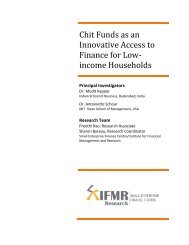Government of India Volume I: Analysis and Recommendations
Government of India Volume I: Analysis and Recommendations
Government of India Volume I: Analysis and Recommendations
Create successful ePaper yourself
Turn your PDF publications into a flip-book with our unique Google optimized e-Paper software.
THE TASKS OF FINANCIAL LAW<br />
be framed by the Central <strong>Government</strong>, in consultation with the RBI. The regulations governing<br />
outward flows should be framed by the RBI, in consultation with the Central <strong>Government</strong>.<br />
5. Systemic risk: Micro-prudential regulation focuses on one financial firm at a time. While this is<br />
important in its own right, there is a requirement for an additional, <strong>and</strong> different, perspective<br />
on risk <strong>of</strong> the financial system as a whole. This requires analysis <strong>of</strong> the entire financial system,<br />
underst<strong>and</strong>ing the build-up <strong>of</strong> risk across all elements <strong>of</strong> the financial system, <strong>and</strong> undertaking<br />
co-ordinated actions (through multiple regulatory agencies) to reduce the probability <strong>of</strong> a systemic<br />
crisis.<br />
The terms financial stability <strong>and</strong> macro-prudential regulation are sometimes used in this discourse.<br />
The Commission has chosen to consistently use the phrases systemic risk <strong>and</strong> systemic<br />
risk regulation as they lend greater clarity in communicating the problem <strong>and</strong> the task.<br />
6. Development <strong>and</strong> redistribution: In addition to the above components <strong>of</strong> financial law, financial<br />
economic governance in <strong>India</strong> is also charged with the objectives <strong>of</strong> development <strong>and</strong> redistribution.<br />
At the same time, these functions need to be placed on sound legal foundation.<br />
7. Monetary policy: The conduct <strong>of</strong> monetary policy is covered by a law that establishes the central<br />
bank <strong>and</strong> defines the triad <strong>of</strong> objectives, powers <strong>and</strong> accountability mechanisms.<br />
8. Public debt management: A specialised framework on public debt management is needed to<br />
cover the function <strong>of</strong> analysing the comprehensive structure <strong>of</strong> liabilities <strong>of</strong> the <strong>Government</strong>, <strong>and</strong><br />
embarking on strategies for minimising the cost <strong>of</strong> raising <strong>and</strong> servicing public debt over the longterm<br />
within an acceptable level <strong>of</strong> risk.<br />
9. Foundations <strong>of</strong> contracts <strong>and</strong> property: A specialised framework setting out the foundations <strong>of</strong> financial<br />
contracts, <strong>and</strong> making adaptations to general commercial laws, is required for the proper<br />
functioning <strong>of</strong> the financial system.<br />
Each <strong>of</strong> these components is associated with a chapter in this report <strong>and</strong> a part in<br />
the accompanying draft <strong>India</strong>n Financial Code (‘draft Code’).<br />
2.1. Shifting away from a sectoral perspective<br />
The discussion above has focused on nine areas <strong>of</strong> work:<br />
◮ Consumer protection<br />
◮ Micro-prudential regulation<br />
◮ Resolution<br />
◮ Capital controls<br />
◮ Systemic risk<br />
◮ Development<br />
◮ Monetary policy<br />
◮ Public debt management<br />
◮ Foundations <strong>of</strong> contracts <strong>and</strong> property<br />
The Commission has prepared a draft Code covering these nine areas. The draft Code<br />
also contains a specialised law to address governance processes associated with regulators<br />
<strong>and</strong> other financial agencies, addressing the problems <strong>of</strong> independence <strong>and</strong> accountability.<br />
Putting these ten elements together, the draft Code constitutes a fairly comprehensive<br />
<strong>and</strong> unified treatment <strong>of</strong> financial law.<br />
This strategy differs from the current <strong>India</strong>n law, which is sectoral in nature. Current<br />
laws are organised around sub-sectors <strong>of</strong> finance, such as securities or insurance or payments.<br />
The Commission debated this at length, <strong>and</strong> concluded that there was merit in<br />
shifting to a non-sectoral approach. Laws must be animated by an economic purpose<br />
<strong>and</strong> the market failures that they seek to address. Once this is done, the ideas apply<br />
consistently across all sectors <strong>of</strong> finance. As an example, a well drafted micro-prudential<br />
law would apply to all components <strong>of</strong> finance. A well drafted regulatory governance law<br />
would apply to all financial agencies.<br />
12 FINANCIAL SECTOR LEGISLATIVE REFORMS COMMISSION



